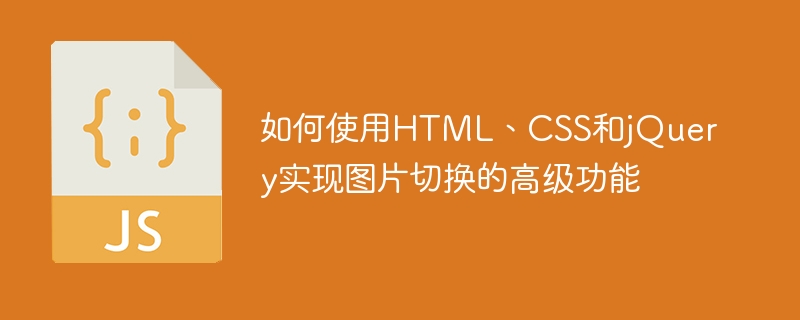

How to use HTML, CSS and jQuery to implement the advanced function of image switching
Introduction:
In modern web design, image switching is a common requirement. By using HTML, CSS and jQuery, we can achieve various forms of image switching effects. This article will introduce you to how to use these technologies to implement advanced functions of image switching and provide specific code examples.
1. HTML and CSS layout:
First, we need to create an HTML structure to accommodate images and switching control buttons. You can use a series of div elements to create a slideshow container, each div represents an image, and add a corresponding class name to each div for style adjustment. Currently, we can use the following HTML layout:
<div class="slideshow">
<div class="slides">
<div class="slide"><img src="image1.jpg" alt="How to use HTML, CSS and jQuery to implement advanced image switching functions" ></div>
<div class="slide"><img src="image2.jpg" alt="How to use HTML, CSS and jQuery to implement advanced image switching functions" ></div>
<!-- 添加更多的图片 -->
</div>
<div class="controls">
<span class="prev">上一张</span>
<span class="next">下一张</span>
</div>
</div>Next, we can use CSS styles to define how these elements are rendered. Here are some basic CSS styling examples:
.slideshow {
position: relative;
}
.slides {
display: flex;
overflow: hidden;
}
.slide {
width: 100%;
opacity: 0;
transition: opacity 0.5s ease-in-out;
}
.slide.active {
opacity: 1;
}
.controls {
position: absolute;
bottom: 10px;
left: 50%;
transform: translateX(-50%);
}The above CSS code ensures the presentation of the image and the position of the control button.
2. jQuery implements image switching:
Using jQuery, we can add click events to control buttons and switch images according to user operations. The following is a simple script example:
$(document).ready(function () {
var slides = $('.slide');
var currentIndex = 0;
// 默认显示第一张图片
slides.eq(0).addClass('active');
$('.next').click(function () {
slides.eq(currentIndex).removeClass('active');
if (currentIndex === slides.length - 1) {
currentIndex = 0;
} else {
currentIndex++;
}
slides.eq(currentIndex).addClass('active');
});
$('.prev').click(function () {
slides.eq(currentIndex).removeClass('active');
if (currentIndex === 0) {
currentIndex = slides.length - 1;
} else {
currentIndex--;
}
slides.eq(currentIndex).addClass('active');
});
});The above code defines a currentIndex variable that is used to track the index of the currently displayed image. In the click event of the next button, we increase the current index value, and if the current index value reaches the maximum index, it is reset to 0. In the click event of the previous button, we reduce the current index value. If the current index value is 0, it is set to the maximum index value.
Conclusion:
Through the combined application of HTML, CSS and jQuery, we can easily realize the advanced function of image switching and add visual effects to the web page. The above is a basic example that you can modify and extend as needed. I hope this article can help you master this technique and achieve satisfactory picture switching effects.
The above is the detailed content of How to use HTML, CSS and jQuery to implement advanced image switching functions. For more information, please follow other related articles on the PHP Chinese website!